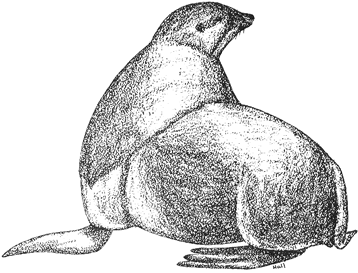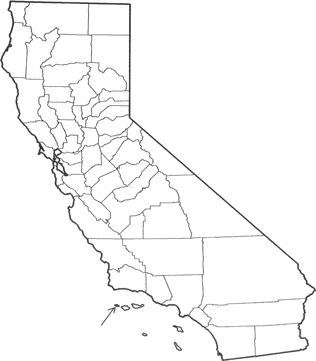
Northern Fur Seal
Distribution, Abundance, and Seasonality
Northern fur seals occur in pelagic waters along the coast of California. Also common on San Miguel Island; occasionally observed on other California islands, and on the mainland. On land, occur in dense rookeries; haul out on offshore rocks, sloping rock outcroppings and sandy or cobble beaches. The breeding colony of 2000-4000 located on San Miguel Island appears to be increasing rapidly (Orr 1972, Fiscus et al. 1976, Le Boeuf and Bonnell 1980). Most of the world population is centered in the Bering and Okhotsk seas. Breeding probably began on San Miguel Island in 1961; females from both the Pribilof and Commander Islands colonized this rookery (Peterson 1968, Le Boeuf and Bonnell 1980). Fur seals spend 9-11 mo each year at sea. Most travel singly or in pairs; small groups of 3, or more, occur. They use offshore waters; usually found at least 18-28 km (11-17 mi) from shore. Often located 50-100 km (31-62 mi) offshore along the continental slope and bottom seamounts where nutrient-rich upwellings and abundant food resources are present (Fiscus 1978, Gentry 1981). Particularly high numbers observed west of San Miguel Island, and within the Southern California Bight, along the Santa Rosa Ridge and over the San Nicolas Basin (Le Boeuf and Bonnell 1980). After the spring/summer breeding season in Alaskan rookeries, females and juveniles travel southward to southern California, and begin to migrate north in March. Fur seals breeding on San Miguel Island do not appear to migrate out of California waters (Johnson 1975, Fiscus 1978).

Range Map
Specific Habitat Requirements
Feeding: Forage opportunistically in offshore waters on fish and squid, including anchovy, hake, rockfish, and mackerel. Small fish and squid may be consumed whole underwater; larger prey broken apart and eaten at surface. Feeding usually takes place at night. Loose aggregations tend to form in areas of abundant food resources. Most feeding dives are 20-130 m (65-426 ft) in depth and last less than 5 min, although dives to 190 m (624 ft) have been recorded (Kooyman et al. 1976, Fiscus 1978, Gentry 1981).
Cover: At sea, observed singly or in small groups in pelagic waters; rest in water in "jug-handle" posture with nose, both hindflippers, and 1 foreflipper extended above the surface. On land, occur in dense aggregations along rocky or sandy insular shorelines and offshore rocks.
Reproduction: Breed on land on large offshore rocks, along rocky or sandy island shorelines (San Miguel); large boulders, rubble, crevices, and tidepools often present (especially in northern rookeries). Highly philopatric, exhibiting marked site tenacity, returning to breed at birthsite. Females feed at sea, returning at regular intervals to nurse pup (Gentry 1981).
Water: Freshwater appears to be derived through fluids in prey consumed, and metabolically produced from body fat stores during periods of fasting on land.
Pattern: Prefer insular breeding sites with nearby food supply and easy access to water.
Species Life History
Activity Patterns: Active yearlong; circadian activity pattern on land; usually nocturnal when feeding at sea (Fiscus 1978, Gentry 1980).
Seasonal Movements / Migration: Breeding colony on San Miguel Island appears to remain in California waters throughout the year. After May to August breeding season, females and juveniles from Bering Sea rookeries make lengthy southward migrations in fall and winter of up to 9600 km (6000 mi) round-trip, while most adult males winter in the Gulf of Alaska. Have been sighted in waters as far south as between Isla de Guadalupe and Islas San Benito off Mexico (Orr 1972, Daugherty 1979). In March, the return migration north begins; "waves" of seals tend to travel together.
Home Range: No information found.
Territory: During breeding season, adult males maintain territories on land. Territories with easy access to water are most favorable, attracting highest proportion of females. Bulls fast while remaining on territory for 3-4 mo, from May or June to August; often returning to same territory each yr (Bartholomew 1953, Peterson 1968, Gentry 1981).
Reproduction: Breed May to August; peak pupping occurs in July. Highly polygynous. Oldest individuals of both sexes arrive earliest in the season, adult males establish territories in May and June. Females begin to haul out in mid-June, give birth to a single pup soon after arrival, and come into a 2-day estrus period 6 days after parturition; most females mate only once. After copulation, females depart to feed at sea; feeding trips become progressively longer (range 4-9 days), although periods of nursing on land consistently last 2 days. Gestation is about 11 mo, with a delayed implantation period of 4 mo. Birth rate is over 80% for females age 7-16 yr. A female might produce up to 16 pups in a lifetime, while male reproductive potential is extremely variable. Lactation lasts 4-5 mo. In Alaska, pups are weaned in October or November and begin the southward migration on their own (Bartholomew 1959, Gentry 1981).
Niche: Occasionally preyed on by northern sea lions, and probably by sharks and killer whales. Some mortality occurs at sea when fur seals become entangled in gillnets or floating fisheries debris, or become contaminated with oil. Several infectious diseases and parasites are known to occur, including hookworm and various microbial infections, which contribute to mortality of pups (Fiscus 1978, Gentry 1981). Juvenile males are harvested annually in northern rookeries during a limited hunting season.
Sources & References
California Department of Fish and Game, 1999.
California's Wildlife, Sacramento, CA.
Written by: M. L. Riedman, reviewed by: H. Shellhammer, edited by: J. Harris, R. Duke
Bartholomew, G. A. 1953. Factors affecting social structure in the Alaska fur seal. Trans. North. Am. Wildl. Conf. 18:481-502. Bartholomew, G. A. 1959. Mother-young relations and the maturation of pup behavior in the Alaska fur seal. Anim. Behav. 7:163-171. Daugherty, A. E. 1979. Marine mammals of California. Calif. Dep. Fish and Game, Sacramento. 61pp. Fiscus, C. H. 1978. Northern fur seal. Pages 152-159 in D. Haley, ed. Marine mammals of Eastern North Pacific and Arctic waters. Pacific Search Press, Seattle, Wash. 256pp. Fiscus, C. H., R. L. DeLong, and G. A. Antonelis. 1976. Population growth and behavior, San Miguel Island. Pages 40-51 in Fur seal investigations, 1976. U.S. Dep. Commerce. NOAA and NMFS, Northwest and Alaska Fish. Center, Marine Mammal Division, Seattle, Wash. Gentry, R. L. 1980. Set in their ways. Oceans 13:34-37. Gentry, R. L. 1981. Northern fur seal-Callorhinus ursinus. Pages 143-160 in S. H. Ridgway and R. J. Harrison, eds. Handbook of marine mammals, Vol. 1. Academic Press, London. 235pp. Johnson, A. 1975. The status of northern fur seal populations. Rapp. P-v. Reun. Cons. Int. Explor. Mer. 169:263-266. Kooyman, G. L., R. L. Gentry, and D. L. Urquhart. 1976. Northern fur seal diving behavior; a new approach to its study. Science 193:411-412. Le Boeuf, B. J., and M. L. Bonnell. 1980. Pinnipeds of the California islands: abundance and distribution. Pages 475-493 in D. Power, ed. The California islands. Santa Barbara Mus. Nat. Hist. 787pp. Le Boeuf, B. J., M. L. Bonnell, M. O. Pierson, D. H. Dettman, and G. D. Farrens. 1976. Numbers, distribution and movements of pinnipeds in the Southern California Bight. USDI, Bur. Land Manage., Wash., DC. Final Rep. 1975-1976. 269pp. Orr, R. T. 1972. Marine mammals of California. Univ. California Press, Berkeley. 64pp. Peterson, R. S. 1968. Social behavior in pinnepeds with particular reference to the northern fur seal. Pages 3-53 in R. J. Harrison, R. C. Hubbard, R. S. Peterson, C. E. Rice, and R. J. Schusterman, eds. The behavior and physiology of pinnepeds. Apple-Century-Crofts, New York. 411pp.
California Animal Facts | California's Wildlife